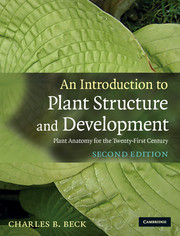Book contents
- Frontmatter
- Contents
- Preface to the second edition
- Preface
- Acknowledgements
- General references
- Chapter 1 Problems of adaptation to a terrestrial environment
- Chapter 2 An overview of plant structure and development
- Chapter 3 The protoplast of the eukaryotic cell
- Chapter 4 Structure and development of the cell wall
- Chapter 5 Meristems of the shoot and their role in plant growth and development
- Chapter 6 Morphology and development of the primary vascular system of the stem
- Chapter 7 Sympodial systems and patterns of nodal anatomy
- Chapter 8 The epidermis
- Chapter 9 The origin of secondary tissue systems and the effect of their formation on the primary body in seed plants
- Chapter 10 The vascular cambium: structure and function
- Chapter 11 Secondary xylem
- Chapter 12 The phloem
- Chapter 13 Periderm, rhytidome, and the nature of bark
- Chapter 14 Unusual features of structure and development in stems and roots
- Chapter 15 Secretion in plants
- Chapter 16 The root
- Chapter 17 The leaf
- Chapter 18 Reproduction and the origin of the sporophyte
- Glossary
- Index
- References
Chapter 18 - Reproduction and the origin of the sporophyte
Published online by Cambridge University Press: 05 June 2012
- Frontmatter
- Contents
- Preface to the second edition
- Preface
- Acknowledgements
- General references
- Chapter 1 Problems of adaptation to a terrestrial environment
- Chapter 2 An overview of plant structure and development
- Chapter 3 The protoplast of the eukaryotic cell
- Chapter 4 Structure and development of the cell wall
- Chapter 5 Meristems of the shoot and their role in plant growth and development
- Chapter 6 Morphology and development of the primary vascular system of the stem
- Chapter 7 Sympodial systems and patterns of nodal anatomy
- Chapter 8 The epidermis
- Chapter 9 The origin of secondary tissue systems and the effect of their formation on the primary body in seed plants
- Chapter 10 The vascular cambium: structure and function
- Chapter 11 Secondary xylem
- Chapter 12 The phloem
- Chapter 13 Periderm, rhytidome, and the nature of bark
- Chapter 14 Unusual features of structure and development in stems and roots
- Chapter 15 Secretion in plants
- Chapter 16 The root
- Chapter 17 The leaf
- Chapter 18 Reproduction and the origin of the sporophyte
- Glossary
- Index
- References
Summary
Perspective: the plant life cycle
Reproduction in higher plants is relatively complex, involving a life cycle consisting of two phases, a diploid sporophyte phase and a haploid gametophyte phase, comprising what is called an alternation of generations. The prominent bodies of angiosperm trees, shrubs, perennials, and annuals as well as those of gymnosperms, ferns, sphenophytes, and lycophytes are sporophytes, having developed from fertilized egg cells (zygotes). The gametes which fused to form the zygotes, however, were produced by gametophytes, very small plant bodies, parasitic on the sporophytes in seed plants, but somewhat larger and free-living in pteridophytes (except in heterosporous species in which gametophytes when mature remain, at least in part, within the walls of the spores from which they develop).
The sporophyte in pteridophytes is dominant, and although dependent initially for its nutrition on the gametophyte, soon becomes independent. The gametophyte is much reduced in size but is free-living and either autotrophic or saprophytic. In seed plants, the sporophyte is also dominant and initially dependent on the gametophyte, but soon becomes independent. The gametophyte is greatly reduced, however, and parasitic on the sporophyte. In angiosperms it is exceptionally small, consisting in many taxa of only seven cells and eight nuclei, and can be observed only with a microscope.
The life cycle of a vascular plant can be summarized as follows. The sporophyte produces specialized cells called sporocytes that undergo meiosis producing haploid spores. The spores germinate to form the gametophytes in which gametes are produced.
- Type
- Chapter
- Information
- An Introduction to Plant Structure and DevelopmentPlant Anatomy for the Twenty-First Century, pp. 361 - 397Publisher: Cambridge University PressPrint publication year: 2010



